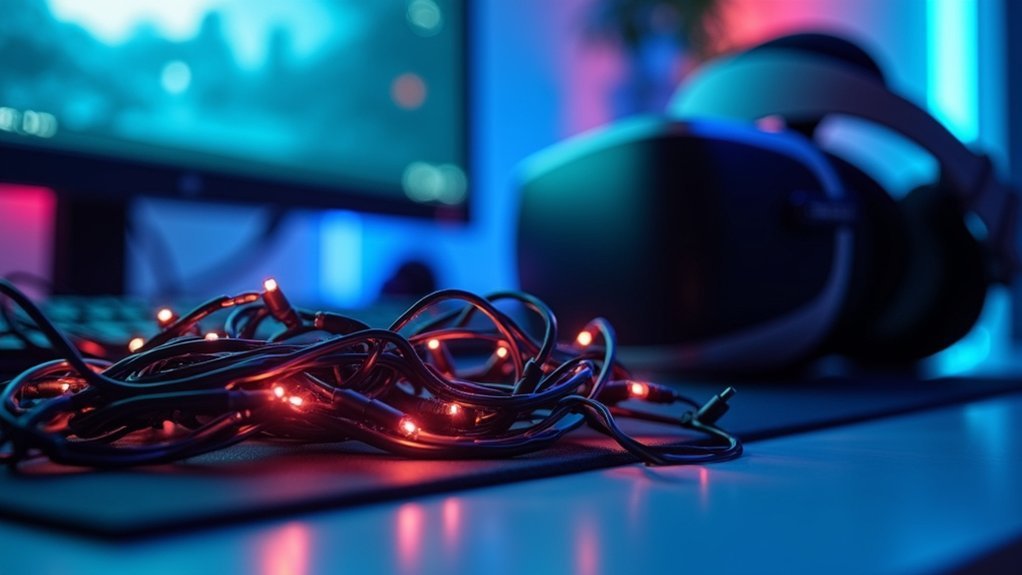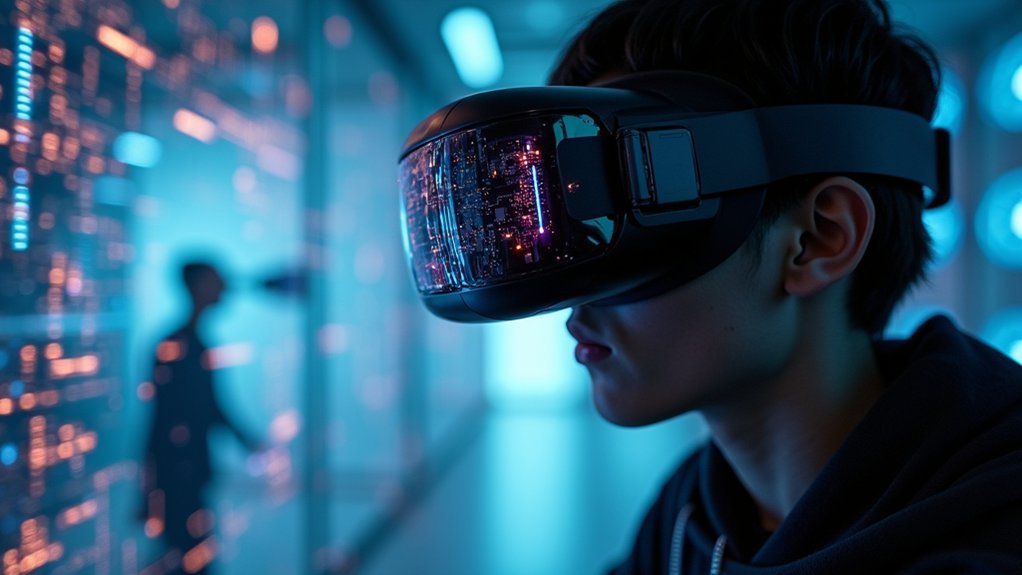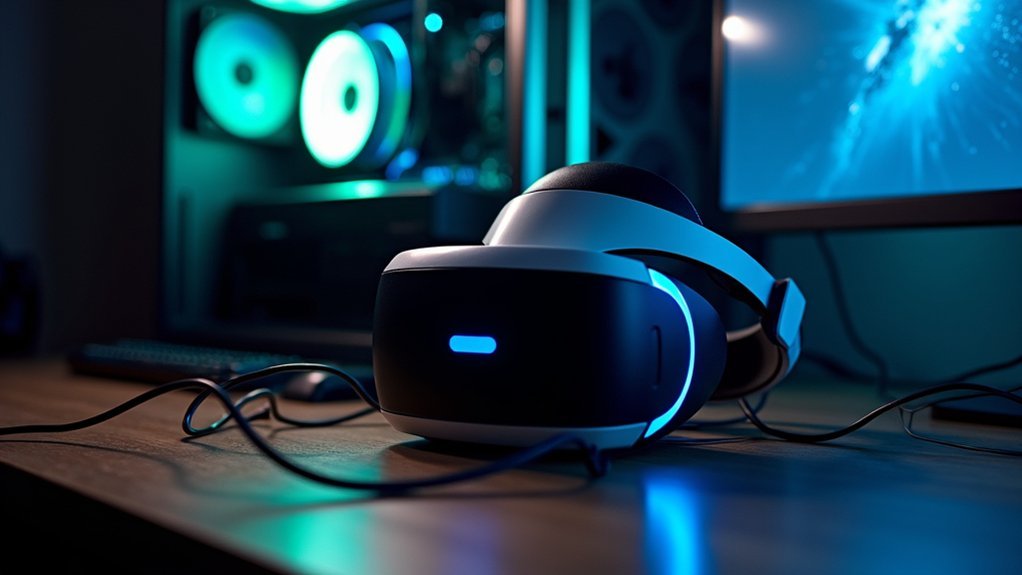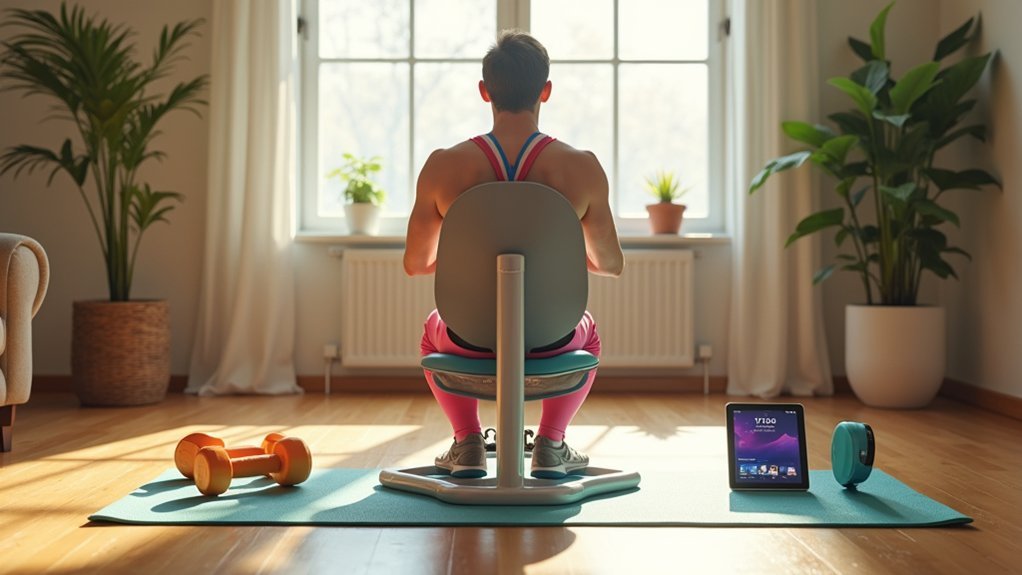Your tethered VR system’s processing capabilities are primarily constrained by thermal throttling, where high-end GPUs reduce performance by up to 30% during extended sessions to prevent overheating. You’ll also encounter bandwidth limitations from HDMI 2.0 and DisplayPort connections, which restrict resolution and frame rates. CPU and GPU bottlenecks, combined with complex real-time rendering demands, create additional strain on your system. The hardware investment required can exceed $3,000 for peak performance, while poor optimization leads to stuttering and compromised visual quality that affects your immersive experience.
Hardware Dependencies That Constrain Performance

While standalone VR headsets offer freedom of movement, tethered systems anchor you to powerful external hardware that determines your entire VR experience.
Your hardware dependencies directly constrain what’s possible in virtual environments. Without high-end CPUs and GPUs, you can’t achieve the visual quality that makes VR compelling.
These tethered devices demand significant processing power to render complex graphics at high frame rates while maintaining the low latency crucial for immersion.
You’re fundamentally limited by your PC’s specifications. Older graphics cards struggle with demanding VR applications, forcing you to compromise on resolution or frame rates.
This creates a constant upgrade cycle where you must invest in newer hardware to access cutting-edge VR experiences, making tethered systems expensive propositions for superior performance.
CPU and GPU Processing Bottlenecks
When you’re running demanding VR applications, your CPU and GPU must meet strict minimum hardware requirements to maintain the essential 90Hz frame rate needed for smooth experiences.
You’ll encounter frame rate bottlenecks when your processing power can’t keep up with real-time rendering demands, causing stutters and increased latency that break immersion.
Additionally, you’ll face thermal throttling issues as your hardware heats up during intensive VR sessions, forcing components to reduce performance to prevent overheating.
Minimum Hardware Requirements
Processing power serves as the cornerstone of any successful tethered VR implementation, demanding substantial computational resources that can strain even modern hardware configurations.
You’ll need minimum hardware requirements that include a high-performance CPU like Intel i5 or AMD Ryzen 5 to handle complex calculations while maintaining low latency. Your powerful GPU must match this performance standard – think NVIDIA GeForce RTX 2060 or AMD Radeon RX 5700 – for rendering high-resolution graphics at consistent 90 FPS rates.
Without meeting these specifications, you’ll experience frame drops and increased latency that create user discomfort.
Your system must manage significant data throughput through DisplayPort or HDMI connections, requiring high bandwidth for peak performance.
Budget constraints often make accessing this high-end hardware challenging for businesses implementing tethered VR solutions.
Frame Rate Bottlenecks
Two critical processing components determine whether your tethered VR system delivers smooth experiences or frustrating stutters. Frame rate bottlenecks occur when your CPU can’t handle complex physics simulations and logic calculations, creating noticeable lag in VR applications.
Your GPU faces even greater challenges, rendering high-resolution graphics for both eyes simultaneously—nearly doubling the processing demands compared to standard gaming.
When either component falls behind, latency issues emerge, creating disorienting delays between your movements and visual feedback. High-resolution textures, advanced lighting effects, and detailed 3D environments push both processors to their limits.
Your CPU processes the computational logic while your GPU renders immersive visuals, but if either component underperforms, you’ll experience stuttering that breaks immersion and potentially causes motion sickness.
Thermal Throttling Issues
As your tethered VR system pushes high-performance components to their limits, thermal throttling becomes an inevitable challenge that can cripple your immersive experience.
When your CPU and GPU reach dangerous temperatures, they automatically reduce performance to prevent overheating, directly degrading graphics quality and frame rates.
VR applications’ intense graphical demands generate substantial heat, creating performance bottlenecks during extended sessions without proper cooling solutions.
You’ll notice the impact immediately—lag, stuttering, and reduced visual fidelity that destroys immersion.
High-end components in tethered systems are especially vulnerable since they operate at maximum capacity to deliver seamless, high-resolution graphics.
Efficient thermal management through improved airflow and advanced cooling technologies becomes critical to maintaining peak processing capabilities and preserving your VR experience’s quality throughout extended gaming sessions.
Data Transfer Bandwidth Limitations
When you’re running a tethered VR system, you’ll quickly discover that cable protocol constraints create significant hurdles for data transmission between your headset and computer.
Your HDMI 2.0 or DisplayPort 1.4 connections can only handle so much bandwidth—18 Gbps and 32.4 Gbps respectively—which directly limits the resolution and frame rates you can achieve.
These bandwidth bottlenecks don’t just reduce visual quality; they’ll cause compression artifacts and latency issues that can break your immersion and even trigger motion sickness.
Cable Protocol Constraints
While modern tethered VR headsets deliver impressive visual experiences, they’re fundamentally constrained by the bandwidth limitations of their cable protocols.
Even HDMI 2.1’s 48 Gbps maximum bandwidth supports 4K at high refresh rates but becomes restrictive for ultra-high resolutions. These cable protocol constraints directly impact your VR experience’s visual fidelity and performance.
Several factors determine your setup’s limitations:
- Protocol capacity – HDMI and DisplayPort standards define maximum data transfer rates
- Cable quality – Poor cables introduce latency and signal degradation
- Cable length – Longer cables increase latency and reduce signal integrity
- Resolution demands – High-resolution displays require exponentially more bandwidth
As VR technology advances toward 8K displays and complex graphics, current protocols struggle to maintain the low latency essential for immersive experiences without compromising visual quality.
Bandwidth Bottleneck Effects
Despite having advanced cable protocols, bandwidth bottlenecks create a cascade of performance issues that directly compromise your VR experience.
When your tethered system can’t transfer sufficient visual data between the headset and computer, you’ll notice immediate performance degradation. Lower frame rates and increased latency become problematic, especially during intense VR sessions where motion sickness risks escalate.
You’ll encounter compression artifacts that noticeably reduce visual quality, undermining the immersive experience you expect.
While HDMI 2.1’s 48 Gbps bandwidth supports higher resolutions and frame rates, many systems still rely on older standards with restricted data transfer rates.
As VR technology advances, implementing faster connections like DisplayPort 2.0’s 80 Gbps capability becomes essential for maintaining peak performance standards.
Cable Connection Constraints and Latency Issues

Although tethered VR systems deliver superior performance through high-bandwidth wired connections, they create significant physical limitations that directly impact your gaming experience.
Cable connection constraints restrict your movement range and can lead to tangling or disconnection during intense sessions.
The primary limitations you’ll encounter include:
- Movement restriction – Cable length determines your play area boundaries
- Physical entanglement – Wires can wrap around your body during gameplay
- Immersion breaking – Constant cable awareness disrupts virtual presence
- Setup constraints – Room layout must accommodate cable routing
While tethered headsets minimize latency issues through high-bandwidth data transfer, you might still experience delays with low-quality cables or insufficient PC processing power.
These constraints force you to balance superior visual fidelity against freedom of movement.
Thermal Management Challenges in High-End Systems
When you’re pushing high-end tethered VR systems to their limits, you’ll encounter significant heat generation from both your GPU and the headset’s internal components working overtime to deliver those crisp visuals and minimal latency.
Your cooling systems often can’t keep up with the thermal load during extended sessions, creating a bottleneck that threatens sustained performance.
You’ll notice your system automatically throttling performance to prevent overheating, which directly undermines the premium experience you’re paying for.
Heat Generation Sources
As tethered VR systems push computational boundaries to deliver immersive experiences, their high-performance CPUs and GPUs become significant heat generation sources that threaten system stability.
When you’re rendering high-resolution graphics at 90+ frames per second, these components work overtime, producing substantial thermal output that directly impacts performance.
Your VR system’s primary heat sources include:
- Graphics Processing Units – Continuously rendering complex 3D environments and visual effects
- Central Processing Units – Managing game logic, physics calculations, and system operations
- Power delivery components – Voltage regulators and capacitors generating heat during power conversion
- Memory modules – RAM and VRAM operating at high frequencies under constant data throughput
Without proper thermal management, you’ll experience throttling, reduced frame rates, and potential hardware damage that compromises your immersive VR experience.
Cooling System Limitations
Even with sophisticated cooling architectures, tethered VR systems face inherent thermal management constraints that can’t fully accommodate the intense heat output from high-performance hardware. You’ll encounter trade-offs that directly impact your system’s capabilities and your immersive VR experience.
| Cooling Challenge | Impact on Performance |
|---|---|
| Fan noise interference | Disrupts audio immersion |
| Space limitations | Restricts cooling capacity |
| Maintenance complexity | Increases system downtime |
| Power consumption | Reduces overall efficiency |
| Cost constraints | Limits cooling effectiveness |
Your cooling systems must balance multiple competing factors. While preventing overheating remains the priority, you can’t ignore how loud fans destroy immersion or how liquid cooling adds maintenance burdens. As VR processing demands escalate, these thermal bottlenecks increasingly determine your system’s maximum performance rather than raw hardware specifications alone.
Performance Throttling Effects
While advanced cooling systems help manage heat generation, your high-end VR hardware will still throttle performance when thermal limits are reached.
Performance throttling directly impacts your system’s ability to maintain consistent processing power during demanding VR sessions.
When thermal management systems activate throttling mechanisms, you’ll experience:
- Frame rate drops that break immersion and cause visual stuttering
- Increased latency between head movements and display updates
- Reduced GPU clock speeds limiting rendering capabilities
- CPU frequency scaling that affects physics calculations and tracking accuracy
These throttling effects create a frustrating cycle where extended gameplay triggers thermal protection, reducing the very processing power needed for smooth immersive experiences.
Your system prioritizes component safety over peak performance, resulting in compromised VR quality precisely when you need maximum computational resources.
Memory Allocation and Resource Management Problems
When you’re running a tethered VR system, your hardware faces an intense juggling act between multiple resource-hungry processes that can quickly overwhelm even high-end components.
Your CPU and GPU must constantly coordinate memory allocation between rendering, tracking, and audio processing while maintaining seamless graphics performance. Poor resource management creates devastating latency issues that shatter immersion through texture pop-in and reduced visual fidelity.
Memory bandwidth limitations compound these problems, throttling data transfer speeds between your GPU and system memory. You’ll notice frame drops when your system can’t efficiently distribute resources across competing processes.
Extended VR sessions amplify these challenges as high-performance components generate excessive heat, forcing thermal throttling that further degrades performance. Without optimized memory allocation strategies, your tethered VR experience suffers from stuttering, visual artifacts, and potential system instability.
Software Optimization Barriers for VR Applications

Beyond hardware constraints, software optimization presents formidable barriers that plague VR application development and performance.
Software optimization hurdles create persistent development nightmares that continuously undermine VR application performance and user experience across all platforms.
You’ll encounter significant challenges when developing tethered VR applications that demand high-fidelity graphics while maintaining smooth operation.
Key software optimization barriers include:
- Complex API mastery – You must navigate intricate frameworks like DirectX 12 and Vulkan, requiring substantial expertise and development time.
- Resource balancing – You’ll struggle to balance high-resolution textures and advanced physics simulations without overwhelming system capabilities.
- Low latency achievement – You need meticulous optimization of both software and hardware components to minimize motion-to-photon delay.
- Multi-threading implementation – You must leverage performance-enhancing techniques like multi-threading to fully utilize desktop-grade GPUs.
These barriers demand specialized development practices that complicate the creation of immersive VR experiences.
Frame Rate and Refresh Rate Processing Demands
The software optimization challenges you’ve just explored directly impact your system’s ability to meet VR’s demanding frame rate and refresh rate requirements.
Your tethered VR setup must deliver 90 Hz or higher refresh rates, updating the display 90 times per second to maintain immersion and prevent motion sickness. These processing demands become even more challenging when you’re rendering high-resolution content exceeding 2160 x 1200 pixels.
You’ll need to keep latency below 20 milliseconds to avoid disorientation during fast-paced activities. Your CPU and GPU face significant strain handling these simultaneous requirements, making powerful hardware essential.
The frame rate consistency directly affects your comfort level, as any drops can trigger nausea or discomfort. Achieving peak performance requires your system to efficiently balance these competing processing demands.
Real-Time Rendering Complexity and System Strain
Real-time rendering pushes your tethered VR system to its absolute limits, demanding that high-end CPUs and GPUs work in perfect harmony to process complex visual elements while maintaining those critical 90+ frames per second.
Your system’s processing power faces unprecedented strain when handling sophisticated environments with advanced lighting, shadows, and physics simulations.
The complexity creates several critical challenges:
- High-resolution visuals requiring up to 4K per eye dramatically increase computational workload.
- Latency optimization becomes essential to prevent motion sickness from rendering delays.
- Advanced lighting calculations consume massive GPU resources during complex scene rendering.
- Real-time physics simulations demand continuous CPU processing for interactive elements.
You’ll need advanced techniques like foveated rendering to optimize performance by adjusting quality based on your gaze, helping alleviate system strain while maintaining visual fidelity.
Cost-Performance Trade-offs in VR-Ready Hardware
When considering tethered VR implementation, you’ll face considerable cost-performance decisions that directly impact your system’s capabilities and budget.
VR-ready hardware demands substantial investment, with powerful CPUs and GPUs costing over $1,000, while dedicated workstations range from $1,500 to $3,000. You’ll also need advanced cooling solutions and upgraded power supplies, further escalating costs.
These cost-performance trade-offs force difficult choices. Budget constraints might push you toward lower-quality settings, sacrificing high-resolution graphics or reducing frame rates. However, these compromises considerably degrade your VR experience and increase motion sickness risk for users.
For smaller businesses, the financial burden of acquiring and maintaining this expensive hardware often becomes prohibitive, limiting market adoption and growth potential across the industry.
Frequently Asked Questions
What Are the Limitations of VR?
You’ll face motion sickness from low frame rates, limited mobility from cables, high hardware costs, complex setup procedures, and dependency on external processing power that creates latency issues during your VR experiences.
What Are the Limitations of VR Therapy?
You’ll face hardware constraints, motion sickness from poor frame rates, high equipment costs, limited therapeutic content, and varying user acceptance. These factors can restrict access and effectiveness of VR therapy treatments.
What Is the Difference Between Standalone and Tethered VR?
You’ll find standalone VR headsets work independently with built-in processors, offering mobility but limited graphics quality, while tethered VR connects to powerful PCs, delivering superior visuals but restricting your movement.
What ARe the Main Limitations of Adopting VR AR Technologies?
You’ll face high hardware costs, processing power demands, and setup complexity when adopting VR/AR technologies. Limited content availability, platform-specific optimizations, and budget constraints for specialized equipment create significant barriers to widespread adoption.





Leave a Reply